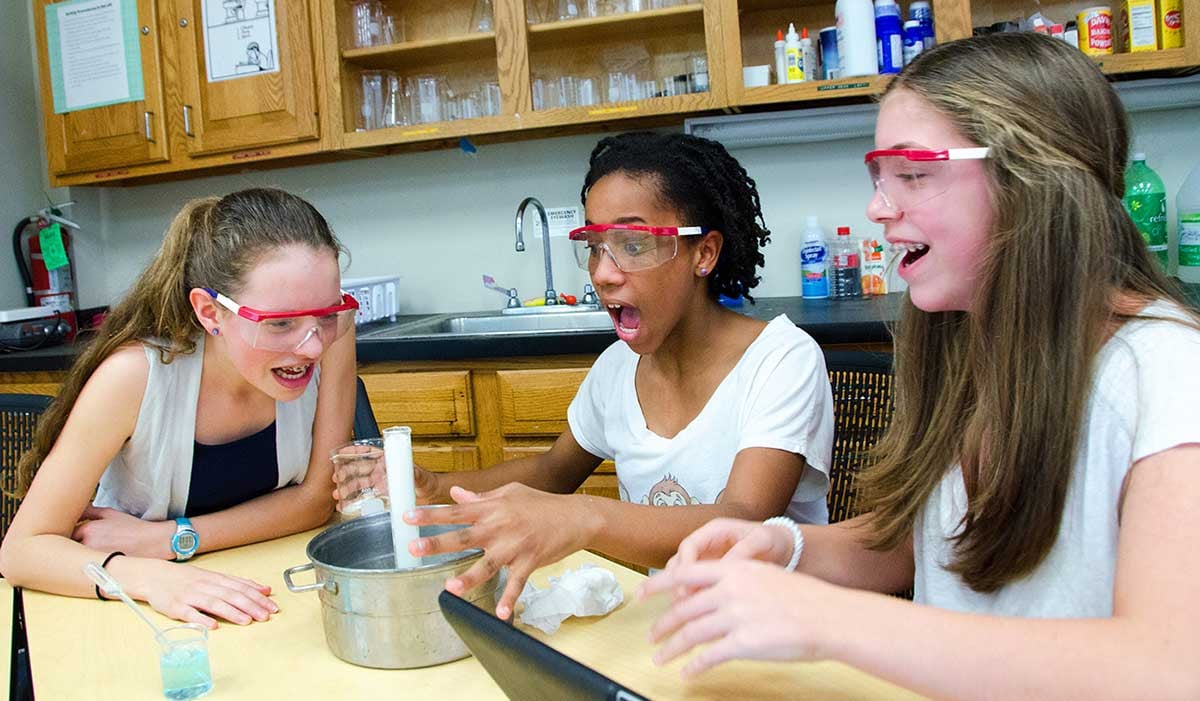
If you were to ask parents or teachers today what subjects would most benefit their child in the long term, they’d probably say STEM: Science, Technology, Engineering, and Mathematics.
And they certainly wouldn’t be wrong. Though all subjects play an important role in raising well-educated, well-rounded individuals, the STEM and STEAM (Science, Technology, Engineering, Arts, and Mathematics) fields have never been more important than they are at this point in time. Thanks to advances in technology, computing, automation, etc., the number of computer- or technology-focused jobs is already at an all-time high, and it’s only expected to balloon even greater by the time that today’s students enter the workforce.
Free Downloadable Guide: Take a Closer Look at Friends' Central School
In order to prepare our kids for the jobs of the future, it’s important for us to start introducing them to science, technology, and math as early as possible so that they can begin to build comfort and proficiency in those fields.
So, what can parents do to help introduce their children to STEM?
Luckily, there are a lot of resources available that today’s parents can use to begin introducing their children to STEM and STEAM from a young age. We discuss some of our favorites below.
1. Maker Websites and Blogs
One of the easiest ways for parents to start introducing their children to STEAM and STEM is to bring the subjects into the home from an early age. Many parents have a lot of success with this by having their children complete activities and projects that are both fun and that help to lay the foundation that their children will need once they enter school.
There was a time that parents would need to purchase an activity book or think back to their own childhood to find inspiration for projects, but in today’s age, it’s incredibly easy to find websites and blogs to offer ideas. We’ve pulled together a list of some of our favorite maker activities here, but below are some other great resources:
2. Educational Toys and Kits
The ability to code and work with robotics is becoming more and more important for today’s kids. Unfortunately, these aren’t the easiest skills for parents to teach their children, especially if they themselves don’t have experience in the field.
Luckily, there has been an explosion of toys, games, and kits in recent years whose aim is to teach children the basics of coding and robotics. These toys and games work to teach children the basics of concepts like logic and rule-following, which forms the foundation of most coding and robotics-focused work. And being designed for kids, they’re usually simple enough for even novice parents to pick up and join along.
Not sure which kits or games make sense for your child? Popular Mechanics has compiled a list of coding kits, and Engadget has compiled a list of robotics kits that you can look to for inspiration.
3. Public Libraries
Another great resource for parents looking to introduce their children to STEM and STEAM? Libraries. In addition to having a plethora of books and other resources on hand for curious minds, many modern libraries have begun to take things a step further by incorporating STEM into their community activities. It’s no longer just story time and puppet shows (though those are important, too, especially for younger children): It’s math days, science fairs, and even tech labs.
For example, the Lower Merion library system (which includes the Ludington, Belmont Hills, Bala Cynwyd, Ardmore, Penn Wynne, and Gladwyne Libraries) regularly offers events for kids, ranging from the traditional story time to coding and math activities that can help little minds start exploring.
4. Makerspaces
Makerspaces that cater to kids and teens are another great option for parents looking to expose their kids to STEM and STEAM, for a few reasons.
For starters, technology like 3D printers, scanners, computers, and design equipment can be prohibitively expensive for many families to afford on their own. Though you’ll need to contribute to the makerspace with dues or an entrance fee, it will undoubtedly be much cheaper than buying the tech on your own. Beyond this, makerspaces allow kids an opportunity to collaborate with others, which is an important skill to start building.
That being said, makerspaces tend to cater more to teens and adults, so these most likely are not the best resource for young kids. Individual establishments will have their own rules, though; for example, NextFab in Philadelphia allows children as young as 10 years old to join at a discounted rate.
5. STEM and Maker Camps
Parents looking to keep their kids busy over summer vacation or during different breaks during the school year might also find a lot of value in different STEM-based camps, which have become more and more popular in recent years, especially among older kids and teens.
Because these camps are generally so immersive, they can be incredibly helpful in teaching kids about science, coding, robotics, and mathematics because of the intensive nature that they tend to take. But kids won’t just be learning the basics: They’ll usually walk away having completed a project that they’ll be proud of, and they’ll have made friendships that are bound to last for years to come.
Activityhero is a website that parents can use to easily find day- and week-long camps and activities for their child in their area. Parents in the Philadelphia area can see an example of robotics and coding camps here.
6. Schools with STEM and Maker-focused Education
Each of the resources listed above is a great way for you to begin introducing your child to STEM at home.
But regular practice is the best way for a child to truly grasp the concepts of science, technology, and math that they’ll need in the future. And the best way for them to get that regular, daily practice is for them to attend a school that prioritizes STEM- and Maker-based education that will reinforce their lessons while helping them think and work with an interdisciplinary, creative mindset.
When evaluating schools to enroll your child in, you should be sure to ask the admissions teams questions like:
- Does your school follow a STEM-, STEAM-, or Maker-based educational philosophy?
- Do you have any teams, clubs, or extracurricular activities that can help my child continue to build their skills?
- Does your school have a makerspace or workshop for student use?
- How do your teachers encourage interdisciplinary, creative, and critical thinking skills?
- How will you help my child see the real-world applications of their lessons?
Preparing for the Future
Introducing your child to STEM is all about preparing them for their future: Teaching them the skills that they’re going to rely on throughout their education and even likely their careers. Especially for younger kids, the best way to do this is to make the lessons fun. The resources above are just a few ways that you can begin introducing your child to STEM and building upon the lessons that they have already learned.



